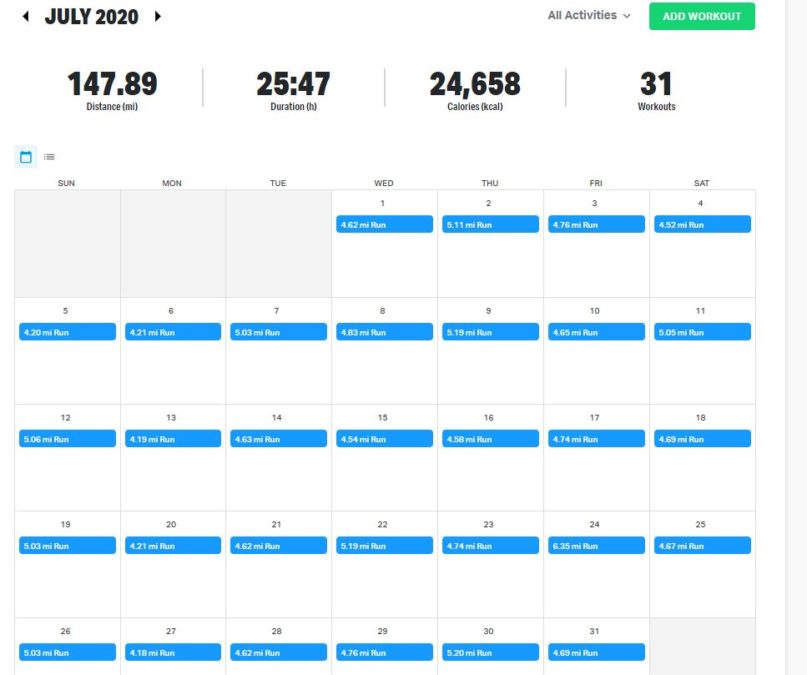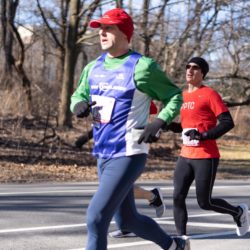August is National Wellness Month, and we are celebrating all month with posts related to wellness and self-care.
=====================
Well, I did it. Ran every day in the month of July! 31 runs and 147.9 miles. Early in the month I wrote about why I was attempting this challenge, and why I wouldn’t be upset if I didn’t finish.
But I did finish!

My average was 4.77 miles per day. Even though the challenge called for 3.1 miles as the minimum run, the minimum I ran was 4.2, and the most was 6.4. Most of my runs were in the 4.7 – 5 mile range, typical for what I would normally do.
In some ways the challenge of running every day was easier than I thought it would be, in that my body didn’t really break down from all the activity (with one exception you’ll read about a few paragraphs down), and while I had to drag myself out a few times, once I get into each run, I really enjoyed them.
It was also more difficult than I thought it would be, mainly in that it felt like a disruption and a job. For me, the best time of the day to run in the hot weather, is in the hour before sunset, so my daily run was constantly interfering with dinnertime, and other family events. Given the cool down and shower time required, each run became a 2.5 hour endeavor. In short, it started to become a job.
The weather was also a significant challenge. I have historically really disliked running in the hot weather. In fact, over 21 years, June/July are the months I run the least, and December/January are the months I run the most! The problem was that every day in July in Jacksonville Florida rivals the hottest days I would experience in New York City. I use the dewpoint as a measurable difficulty factor, and over the past month, the average dewpoint during my runs was 76, which is a very high number, and one that I would rarely ever see in New York City.
The other issue was the discomfort in my left heal (plantar fasciitis) I had mentioned it in my earlier post. At the start of the month, I had already been aware of it as a fairly new pain, but one that was not yet affecting my running. I tried to take good care of it with lots of stretching, and did a good job early in July, but slacked off a bit, and over the course of the month it progressively get a bit worse. It only started hurting while running on day 27, and since I was so close to the end of the challenge at that point, I stepped up the self-care, and went ahead with running the last few days. At this point, I’ll be more careful with it, and work to get it better. As I write this, after 2 days off from running, and lots of self care, it already feels much better.
With that basic summary out of the way, over the course of July, I came up with 31 observations about running.
But first, if a running streak is something you want to try, or you are looking for a way to be more accountable with your running, or you simply want a more fun way to track your runs, check out the latest product in our Etsy shop: a printable Monthly Running Calendar And Log
Also, if you are into that sort of thing, go ahead and friend me on Strava.

1) I miss New York City – For as much as I disliked running in the New York summer, running in Jacksonville has been much worse! There is very little break from the heat and humidity. Many days in July are as hot or hotter than the worst summer days in New York City. The pandemic has us spending more time in Jacksonville than planned, but I’m looking forward to getting back to New York at some point for some cooler running weather!
2) 31 days of running did not result in weight loss – I weighed the same on July 31 as I did on July 2. My average weight over the course of July was down 3 pounds, as compared to my average weight in June, but that decrease is really just negligible. I am a firm believer that real weight loss requires a nutritional overhaul – and when I did that last year, I lost 18 pounds in just one month!
3) Variety in running routes is needed – It would have been tough to run same route every day or multiple times per week. My neighborhood is not runner friendly for a variety of reasons, but I was able to make enough routes so that I didn’t have to repeat any during a given week. Some of the runs did require a short drive in my car though.
4) Used the extra running days to explore new routes – With some experimentation, I was able to find some new routes around or near my neighborhood. I also was able to rediscover a route I had run once back in November and hated, but in retrospect and compared to the other routes in my neighborhood, it is not that bad. I ran it several times in July and am happy for it to be part of my routine going forward.
5) Dreft laundry detergent for the win! – Regular laundry detergent simply doesn’t do a good job of fully cleaning the sweat of the clothes after a summer run. In July we started using Dreft, which we had been familiar with from when our kids were small, and I’m noticing a big improvement in how clean the clothes come out of the wash. There are other detergents formulated specifically for sports use, which I’m sure would be fine. They are more expensive, but well worth it in the summer time.
6) Five sets of each type of clothing is required – I was able to have enough clothes to get by for a daily run by adding a mid-week wash after 4 days. So, five sets of everything was enough to get by – socks, shorts, shirts, etc.
7) Cap vs visor vs headband – A cap is fine for me most of the year, helpful for absorbing sweat and blocking the sun. In the summer though, a visor is preferred as it allows more body heat to escape from the top of the head. But if not sunny or rainy, then a headband (or buff) is even better as it will absorb the most sweat. I rediscovered my buff and used it many times this July. I recently read this Wired article about the Treadband, and I’m intrigued – in fact, I have several on the way in the mail.
8) Discovered rotating 2 pairs of running shoes – I’ve always just run using a single pair of shoes, using that pair exclusively until it starts to break down, and then I’d replace it. This month I bought a 2nd pair of the same shoe so that I can swap them out every few runs. It has proven helpful in the summer since my shoes start to smell from sweat, and I can wash one pair while using the other pair, or simply let one air out for a few days.
9) Daily running habit didn’t make me slower – I was afraid running daily would tax my muscles, create soreness, and make me slower, but that was not the case. Yes, I was slow on very hot days, and on certain days where I dialed back the effort, but on day 29, I had my fastest effort on a route I ran 4 other times over the month, which surprised me.
10) Speedwork was not a problem – The best way to get faster with running is to do periodic speedwork. While ideally I would do one speed workout per week, for July I did it every other week. Not only did it not cause any injury issue, but I was able to run equally as fast as when I’ve done speedwork in other months. My average pace per mile over the month was probably around 10 minutes 15 seconds, but my fastest mile in speedwork was a speedy 8:17!

11) Daily running habit didn’t create new injuries – While I started the month with a plantar fasciitis, which did get worse towards the end of the month, I had no other muscle soreness or injury issues. I was particularly worried about my knee, which has a partial meniscus tear, but it was totally fine.
12) Daily running habit made existing injury worse – As you could probably guess, running every day with an injury isn’t wise. I had a mild case of plantar fasciitis going in, and it did get progressively worse. It only started hurting while running on day 27, so I did finish the challenge, but when you have an injury at the onset, be very careful, and consider stopping, especially if the injury hurts when running.
13) Running to podcasts doesn’t work for me – I either run with music or no audio at all. I have found that I am not able to run while listening to podcasts, and especially funny ones. With music, it is in the background, and I can just focus on running, or let my mind wander elsewhere. With podcasts, I can’t focus on both the content and the running, and my running suffers. I did try in July, and reaffirmed that music works much better for me.
14) For daily running, variety in music is needed – Running to the same playlist every day, or even genre of music, can get boring. I switch between 3 different sources: music I own via iTunes, music I like via Pandora, and Casey Kasem throwback countdowns on iHeart Radio (your welcome)
15) Stash cold water bottle outside for after the run – After a run in the Florida summer weather, even in the evening, it takes me a good 30 minutes to cool down and stop sweating. I have gotten into the habit of cooling down outside, and I finally realized that I could stash a cold bottle or water or Gatorade outside before the run, and then I’d have a cold drink to enjoy after the run and to assist with cooling down.
16) Gatorade Powder – I usually just rely on water as a liquid replenishment after short runs, but in the hot weather, water is not enough. Rather than buying lots of bottles of Gatorade or Powerade, I’ve started using Gatorade powder, mixing it myself, and leaving a pitcher in the fridge. BJ’s Wholesale sells a giant can of Gatorade powder for around $10, which makes about 9 gallons, or in my case, way more since I use less powder than directed.
17) Run carrying water when 75 dewpoint or higher – For short runs (6 miles or less), I usually don’t run carrying water. However, I’ve found that I need it when the dewpoint is 75 degrees or higher. That is the limit where runs get really difficult, and drinking some water every 1-2 miles is a big help.
18) Ice cubes that fit into water bottles – On occasions I do run with water, or for help keeping the bottles cold that I stash outside for after my run, I bought an ice cube tray that makes narrow cubes that fit into narrow bottle openings. Genius! This is the one I bought. Keep in mind that the ice cubes are too wide for a standard half liter water bottle, but fits great in Gatorade/Powerade bottles, and other bottles geared towards exercise.
19) Don’t need to pay for virtual event to challenge yourself – Many ‘virtual events’ cost money to join, but it isn’t necessary to pay. The virtual event I entered (operated on MapMyRun) was free. Strava also has no shortage of challenges to join in the Explore tab. The advantage of paying for an event is that you will probably receive a shirt and a medal, and you’ll also be providing support to the hosting running club. Pay if you want swag and to support your local club, but it is not necessary.
20) Speaking of Strava, it is a fun and motivating platform – there has been some controversy with Strava recently, as they have reduced the functionality you get as a user on their free tier (which is what I use), but there is still plenty to love about it. I have enjoyed making friends on the platform, encouraging them with a simple thumbs up, and following their workouts. I’ve found and joined local running groups on the platform, and also joined a few challenges. Making sure to log my run every day in the app was definitely a motivator to keep going. If you are on Strava, go ahead and friend me!

21) Summer time: best time of day to run – for me, from a weather point of view, the best time of day to start a run is 30-45 minutes before sunset. Daytime, especially when the sun is out, will be hottest, of course. But morning time is generally more humid than the evening time, reason being that the air temperature is lower, and closer to the dewpoint. When dewpoint is 75, for example, as it often is here in the summer in Jacksonville, I’d much rather run late in the day with a temperature of 85 then early in the morning when the temperature is 78 – the morning humidity is killer (for me)!
22) Summer time: next best time of day to run – actually, my best running occurred on days where thunderstorms hit in the mid-afternoon, and I was able to get out to run right after the rain, or even in the tail end of the rain. When afternoon storms hit, the air temperature drops, there is usually some nice wind, and if you can be out in the light rain, that is cooling too. By mid-month, I learned to watch the weather map for afternoon thunderstorms, and then try to arrange my time to run right at the tail end of the storm.
23) Discovered how to do a long run in the hot weather – I tried to do some long runs early in the month, and was never able to get it done. After 5-6 miles, I would be completely and totally DONE. However, I eventually remembered that run/walk can be very effective. Later in the month I did a longer run with several cycles of 9 minutes running and then 2 minutes walking. Yes, the overall time was slower, but that routine made it much easier to get through a longer distance.
24) Really long runs though are still a bad idea when running every day – I didn’t get to test out this theory because I had such a hard time getting long runs in, but I still believe that it is not wise to do a really long run when trying to run every day. With my normal run in the 4.2-5.2 mile range, I think 8-9 miles would be as long as I would want to run with a daily habit.
25) As a daily habit, a run needs to be on the schedule – while I normally just run when convenient on a ‘run day’, in this hot weather there are only specific times in the day I am willing to run. Therefore I learned that I had to schedule everything else around it. Some days I’d make sure to check in with my family on my run plan, so that family activities (such as dinner) could be worked around it.
26) Starting to drag late in the day? Go for a run – as someone who works from home, my days tend to be flexible, especially during this pandemic. While I prefer to run late in the day, or after an afternoon rainstorm (see #21 and #22), another alternative is go run when your body starts to drag. When your body is telling you it is nap time, that can also just be a signal you need a break or a diversion. On a couple of days when dragging in the afternoon, I’d go for a run instead, and I was surprised that my run did not suffer, and after the run, felt I was alert enough to continue working.
27) It is OK to take walk breaks or shut it down early – The most important thing is getting out there and doing just what feels comfortable, especially in the hot weather. There is no need to push yourself unnecessarily. I cut several runs short when I wanted to run long, but couldn’t. I also took walk breaks during a few of the runs that occurred on the hottest days. It simply is not worth risking injury or other problems by over pushing, especially when you are trying to run every day.
28) That said, some workouts should be completed, even if you have to walk – every Monday night I did a local group run. It is a challenging run, over 2 bridges, and of course even more challenging on the hot days. Given that the run is the same every week, and I’m participating with people that are both faster and slower than me, I personally treat it almost like a race. For that type of run, I like being able to measure the best and the worst, even if it involves walking. Sometimes people cut the run short if the weather is really hot, but I’d rather do the full route, and walk if necessary, so I can have a good measurement of my worst effort.
29) Don’t let the probability of failure prevent you from getting started – Going into the 31 day running challenge, I thought there was a good chance of failing, but I didn’t let that stop me from starting. Even if I didn’t make it through the full 31 days, the journey of pushing new boundaries would be meaningful and satisfying, and I might still pick up new good habits along the way. I’m glad I went through with it.
30) Will not continue with daily running habit – I’m glad I made the effort to run 31 straight days, but at this time I’m not looking to continue. Running every day in the summer time is just too disruptive between the extra time it takes to cool down, and the limited times of the day I can go out to run. Once the weather cools off, I can definitely see myself trying it again.
31. But I likely will do more running overall going forward – In the past, I would generally not run more than 2 or 3 days in a row due to the fear of overdoing things or getting injured. But this past month has told me that running every day is really not a problem. In the past when not injured, I would average about 3 runs per week, but I can see myself averaging somewhere between 4 and 5 runs per week. I’m looking forward to stepping it up, and I’m curious to look at the averages the rest of the year, to see if the daily running habit in July results in more runs the remaining months of the year.
=====================
If you got this far, thanks! If you are on Strava, go ahead and friend me. And please check out our new downloadable Running Calendar and Log in our Etsy store.
Happy wellness month!
NOTE: Photo at the top of the page is me at the iconic photo spot in one of my favorite marathons, Big Sur, back in 2005.


 We are Scott and Caroline, 50-somethings who spent the first 20+ years of our adult lives in New York City, working traditional careers and raising 2 kids. We left full-time work in our mid-40’s for location-independent, part-time consulting projects and real estate investing, in order to create a more flexible and travel-centric lifestyle.
We are Scott and Caroline, 50-somethings who spent the first 20+ years of our adult lives in New York City, working traditional careers and raising 2 kids. We left full-time work in our mid-40’s for location-independent, part-time consulting projects and real estate investing, in order to create a more flexible and travel-centric lifestyle.  Financial independence and early retirement is not something we originally focused on, but over time realized it was possible. Our free report,
Financial independence and early retirement is not something we originally focused on, but over time realized it was possible. Our free report, 








Congrats on running 31 days straight. I run a few times each week. I ran 18 times in July and that was a record. I may try and push myself and try 31 days staright sometime next year.
Thanks Jason! At this point, I definitely regret pushing through the entire challenge, because plantar fasciitis / heel pain is not to be messed with. I’ve run just 3 times since July 31! I think I’m finally on the mend, and will test a mile or 2 this weekend. Hoping to put that behind me shortly, so I can enjoy some fall running…